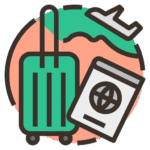Car Rentals & Driving in Japan
Essential Travel Tools for Japan
Every trip starts with the basics. These tools are the backbone of traveling in Japan. From transport to internet, we’ve listed the essentials every visitor needs — with direct links to our in-depth guides.
🔑 How to Rent a Car in Japan — Step by Step
Renting a car in Japan gives you maximum freedom for rural sights, onsen towns and islands. Follow this flow — from documents to tolls — and you’ll be on the road in minutes.
1 Check requirements before you book
- International Driving Permit (IDP) based on the 1949 Geneva Convention + your valid driver’s license.
- Minimum age is usually 18–20; some classes (e.g., vans) may require 21+ or 24+.
- Credit card in the driver’s name for deposit; prepaid/debit often not accepted.
- Insurance: basic liability is included; confirm CDW and NOC (non-operation charge) options.
2 Compare cars, coverage and pickup points
- Filter by automatic transmission (default in Japan), luggage capacity and fuel policy.
- Pick convenient locations: airport counters (Narita/Haneda/Kansai) or city stations (Tokyo, Kyoto, Sapporo, Naha).
- Add-ons: child seats (legally required), ETC card for cashless tolls, winter tires (Hokkaido/Tohoku winter).
3 Confirm your booking details
- Driver name must match passport, license and credit card.
- Check mileage policy, fuel (return full vs. prepay), one-way fees, and opening hours.
- Save the voucher/QR and pickup map to your phone for offline access.
4 Pickup: documents & vehicle inspection
- Bring passport, home license, IDP, and credit card (same driver).
- Take photos of the car (all sides, wheels, interior fuel gauge) before leaving.
- Ask for the ETC card if you added it, and confirm the toll settlement method.
- Set the navigation to English (most cars offer ENG/ROMAJI) and add your first stops.
5 Driving essentials: rules, tolls & parking
- Drive on the left. Speed limits: typical 60 km/h urban, 80–100 km/h on expressways (signed).
- ETC lanes are purple; use them only with an ETC card inserted. Otherwise choose general/cash lanes.
- Parking: coin lots and multistory garages are common; avoid street parking to prevent fines/towing.
- Alcohol limit is near zero — do not drink and drive.
6 Seasonal & regional tips
- Hokkaido / Tohoku (winter): request studless winter tires; drive gently on ice; keep extra time.
- Japanese Alps: mountain roads can be narrow; check closures and weather.
- Okinawa: ideal for coastal loops; prebook during holidays and summer.
7 Return the car smoothly
- Refuel to the level required (keep receipt if asked).
- Return at the exact location on your contract; allow time for inspection.
- Confirm ETC tolls charged, mileage and any late/one-way fees before you leave.
❓ Car Rental in Japan — Frequently Asked Questions
Do I need an International Driving Permit?
Yes. Most visitors must carry a 1949 Geneva Convention IDP + their valid home license. Some countries/permits are not accepted; check before booking.
What’s the minimum age to rent?
Usually 18–20 minimum; some vehicle classes or providers require 21+ or charge a young-driver fee.
Can I rent without a credit card?
Typically no. A credit card in the driver’s name is required for the security deposit.
What is ETC and do I need it?
ETC is an electronic toll system. With an ETC card, you can use purple ETC lanes and tolls are charged automatically. It saves time and often money on expressways.
Is GPS available in English?
Yes in most rental cars. You can switch language to English and navigate using phone numbers or map codes (mapcode) for accurate pinpoints.
How expensive are tolls and fuel?
Expressways are tolled; typical long intercity routes can cost the equivalent of US$20–60. Gasoline is usually more expensive than in the US but similar to Western Europe. Plan accordingly.
Do I need winter tires?
Yes for Hokkaido/Tohoku (winter) and often for mountain regions. Request studless tires at booking; chains may be required on certain roads.
What is NOC (non-operation charge)?
A flat fee charged if the car needs repair/cleaning and cannot be rented. CDW doesn’t always cover NOC; consider adding additional protection to reduce this risk.
Can I do one-way rentals between cities?
Usually yes, but one-way fees apply. They can be high across regions/islands; check the quote before confirming.









